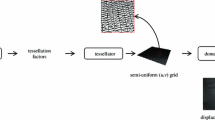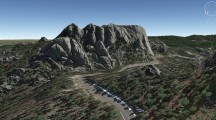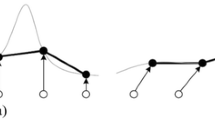Abstract
In this paper we present a novel GPU-oriented method of creating an inherently continuous triangular mesh for tile-based rendering of regular height fields. The method is based on tiling data-independent semi-regular meshes of non-uniform structure, a technique that is quite different from other mesh tiling approaches. A complete, memory efficient set of mesh patterns is created by an off-line procedure and stored into the graphics adapter's memory at runtime. At rendering time, for each tile, one of the precomputed mesh patterns is selected for rendering. The selected mesh pattern fits the required level of details of the tile and ensures seamless connection with other adjacent mesh patterns, like in a game of dominoes. The scalability potential of the proposed method is demonstrated through quadtree hierarchical grouping of tiles. The efficiency is verified by experimental results on height fields for terrain representation, where the method achieves high frame rates and sustained triangle throughput on high resolution viewports with sub-pixel error tolerance. Frame rate sensitivity to real-time modifications of the height field is measured, and it is shown that the method is very tolerant and consequently well tailored for applications dealing with rapidly changeable phenomena represented by height fields.
Similar content being viewed by others
References
Duchaineau M, Wolinsky M, Sigeti D, Miller M, Aldrich C, Mineev-Weinstein M. ROAMing terrain: Real-time optimally adapting meshes. In Proc. Visualization 1997, Phoenix, USA, Oct. 19–24, 1997, pp.81-89.
Hoppe H. Smooth view-dependent level-of-detail control and its application to terrain rendering. In Proc. Visualization 1998, Research Triangle Park, USA, Oct. 18–23, 1998, pp.35-42.
Lindstrom P, Pascucci V. Terrain simplification simplified: A general framework for view-dependent out-of-core visualization. IEEE Trans. Visual. Comput. Graphics, 2002, 8(3): 239–254.
Pajarola R. Large scale terrain visualization using the restricted quadtree triangulation. In Proc. Visualization 1998, Research Triangle Park, USA, Oct. 18–23, 1998, pp.19-26.
Röttger S, Heidrich W, Slusallek P, Seidel HP. Real-time generation of continuous levels of detail for heightfields. In Proc. WSCG1998, Plzen-Bory, Czech, 1998, pp.315-322.
Levenberg, J. Fast view-dependent level-of-detail rendering using cached geometry. In Proc. IEEE Visualization 2002, Boston, USA, Oct. 27-Nov. 1, 2002, pp.259-266.
Ulrich T. Rendering massive terrains using chunked level of detail. ACM SIGGraph Course “Super-size it! Scaling up to Massive Virtual Worlds”, 2002.
Dick C, Schneider J, Westermann R. Efficient geometry compression for GPU-based decoding in realtime terrain rendering. Comput. Graph. Forum, 2009, 28(1): 67–83.
Bösch J, Goswami P, Pajarola R. RASTeR: Simple and efficient terrain rendering on the GPU. In Proc. EUROGRAPHICS 2009, Munich, Germany, Mar. 30-Apr. 3, 2009, pp.35-42.
Cignoni P, Ganovelli F, Gobbetti E, Marton F, Ponchio F, Scopigno R. BDAM — Batched dynamic adaptive meshes for high performance terrain visualization. Comput. Graph. Forum, 2003, 22(3): 505–514.
Larsen B D, Christensen N J. Real-time terrain rendering using smooth hardware optimized level of detail. Journal of WSCG, 2003, 11(2): 282–289.
Livny Y, Kogan Z, El-Sana J. Seamless patches for GPU-based terrain rendering. The Visual Computer, 2009, 25(3): 197–208.
Schneider J, Westermann R. GPU-friendly high quality terrain rendering. Journal of WSCG, 2006, 14(1–3): 49–56.
Asirvatham A, Hoppe H. Terrain Rendering Using GPU-Based Geometry Clipmaps. GPU Gems 2, Pharr M (ed.), Addison Wesley, 2005, pp.27-45.
Hwa L M, Duchaineau M A, Joy K I. Real-time optimal adaptation for planetary geometry and texture: 4–8 tile hierarchies. IEEE Transactions on Visualization and Computer Graphics, 2005, 11(4): 355–368.
Đurđvić Đ. Dynamic reconfiguration of terrain models with irregular borders [Magistral Thesis]. Department of Computer Engineering and Information Theory, School of Electrical Engineering, University of Belgrade, 2006. (In Serbian)
Pajarola R, Gobbetti E. Survey of semi-regular multiresolution models for interactive terrain rendering. The Visual Computer, 2007, 23(8): 583–605.
Pomeranz A A. ROAM using surface triangle clusters (RUSTiC) [Master’s Thesis]. University of California at Davis, 2000.
Goswami P, Makhinya M, Bösch J, Pajarola R. Scalable parallel out-of-core terrain rendering. In Proc. Eurographics Symposium on Parallel Graphics and Visualization, Norrköping, Sweden, May 2–3, 2010, pp.63-71.
Cignoni P, Ganovelli F, Gobbetti E, Marton F, Ponchio F, Scopigno R. Planet-sized batched dynamic adaptive meshes (P-BDAM). In Proc. IEEE Visualization 2003, Seattle, USA, Oct. 18–24, 2003, pp.147-154.
Roca J, Moya V, Gonzalez C, Escandell V, Murciego A, Fernandez A et al. A SIMD-efficient 14 instruction shader program for high-throughput microtriangle rasterization. The Visual Computer, 2010, 26(6–8): 707–719.
Samet H. Foundations of Multidimensional and Metric Data Structures, The Morgan Kaufmann Series in Computer Graphics and Geometric Modeling. Morgan Kaufmann Publishers Inc., 2005.
http://gis.utah.gov/, May 2011.
http://www.cc.gatech.edu/projects/large_models/ps.html, May 2011.
http://code.google.com/p/cudpp/, May 2011.
Author information
Authors and Affiliations
Corresponding author
Additional information
This work was partially supported by the projects TR32039 and TR32047 of the Ministry of Science and Technological Development of Serbia.
Electronic Supplementary Material
Below is the link to the electronic supplementary material.
Rights and permissions
About this article
Cite this article
Đurđević, Đ.M., Tartalja, I.I. Domino Tiling: A New Method of Real-Time Conforming Mesh Construction for Rendering Changeable Height Fields. J. Comput. Sci. Technol. 26, 971–987 (2011). https://doi.org/10.1007/s11390-011-1194-8
Received:
Revised:
Published:
Issue Date:
DOI: https://doi.org/10.1007/s11390-011-1194-8




